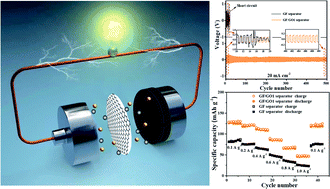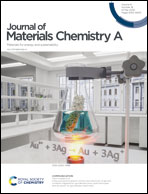A universal and facile approach to suppress dendrite formation for a Zn and Li metal anode†
Abstract
To solve the poor cycling stability of zinc ion batteries (ZIBs) caused by the growth of zinc (Zn) dendrites, a novel method of separator modification is proposed. Herein, graphene oxide (GO), which has many outstanding properties, is applied as a modified material to a glass fiber (GF) separator using a simple vacuum filtration method. A stable and dendrite-free Zn anode can be obtained after 500 cycles in a Zn//Zn symmetrical battery when using a modified separator (GF/GO1), which is mainly owing to the preferential growth of the non-protruding crystal planes of the zinc metal and the uniform nucleation of zinc ions under the action of GO. As proof of concept, full Zn//MnO2 batteries with a GF/GO1 separator exhibited a high specific capacity of 126 mA h g−1 at 0.1 A g−1, a high energy density of 327.5 W h kg−1 (power density of 0.517 W kg−1), and a high power density of 20.8 kW kg−1 (energy density of 253.8 W h kg−1), demonstrating significant improvements compared with the unmodified GF separator. Meanwhile, ZIBs with a GF/GO1 separator exhibited excellent long-term stability with less than 25% capacity fade over 500 cycles at a current density of 0.5 A g−1. ZIBs with a GF separator retain only 37% of their initial capacity after 100 cycles. Furthermore, the GF/GO1 separator can also help to improve the cycle performance and rate performance of lithium metal batteries and to achieve a dendrite-free lithium anode. Full batteries of Li//GF/GO1//LiCoO2 show improved rate and cycling capabilities. A higher energy density of 537.1 W h kg−1 at 0.04 kW kg−1 and higher power density of 1.4 kW kg−1 at 264.6 W h kg−1 can be achieved with a GF/GO1 separator, which is better than many Li metal batteries. This modification of the separator provides an effective approach to designing next-generation batteries exhibiting excellent rate and cycling capabilities, and high energy and power densities.



 Please wait while we load your content...
Please wait while we load your content...